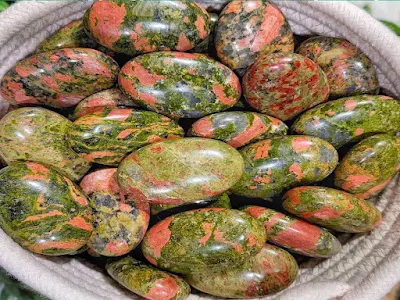Unakite: Gemstone, Properties, Uses
Unakite is a metamorphic rock composed primarily of green epidote, pink orthoclase feldspar, and clear to milky quartz. It is characterized by its distinctive mottled pattern of pink and green, which resembles moss growing on brick. Unakite is often used as a semiprecious gemstone in jewelry and for ornamental purposes.
Unakite is found primarily in the Unakas Mountains of western North Carolina and eastern Tennessee, hence its name. However, it also occurs in other parts of the world, including South Africa, Norway, and Finland.
.jpg) |
| Tumbled polished unakite pebbles |
Formation of Unakite
Unakite originates from the alteration of granite, an igneous rock formed from the solidification of molten magma. During metamorphism, the original minerals in granite undergo transformation due to elevated temperatures and pressures. In the case of unakite, plagioclase feldspar, a common component of granite, is replaced by epidote, a mineral that imparts the characteristic green color. The pink hues stem from orthoclase feldspar, while quartz contributes the clear or bluish-gray patches.
The formation of unakite is typically associated with convergent plate boundaries, where tectonic forces push Earth's plates together, causing deep burial and deformation of rocks. These elevated temperatures and pressures facilitate the metamorphic processes that give rise to unakite's distinctive appearance.
 |
| Tumbled Unakite: Gemstone |
Properties of Unakite
Composition: Unakite is not a single mineral, but rather a granitic rock composed of three main minerals:
- Orthoclase feldspar: Potassium aluminum silicate (KAlSi₃O₈) - pink or salmon color
- Epidote: Calcium aluminum iron silicate hydroxide (Ca₂Fe³⁺(Al,Si)₃O₁₂(OH)) - green color
- Quartz: Silicon dioxide (SiO₂) - clear, white, or gray color
Color: Unakite is known for its unique mottled appearance, with shades of pink, green, and sometimes white or gray. The pink color comes from the orthoclase feldspar, the green from the epidote, and the white/gray from the quartz.
Transparency: Unakite is opaque, meaning light cannot pass through it.
Luster: Unakite typically has a vitreous (glassy) to greasy luster.
Streak: The streak of unakite is white due to the presence of quartz. Streak refers to the color of the powder left when a mineral is scratched against a streak plate.
Hardness: Unakite has a hardness of 6 to 7 on the Mohs scale, meaning it can be scratched by steel or quartz but not by a fingernail.
Fracture: Unakite has a conchoidal to uneven fracture, meaning it tends to break with smooth, curved surfaces or irregular, jagged edges.
Solubility: Unakite is insoluble in water and most common acids.
Fluorescence: Unakite generally does not exhibit fluorescence under ultraviolet light.
Pleochroism: Some varieties of unakite, particularly those with a high concentration of epidote, may exhibit pleochroism, meaning they appear to change color depending on the viewing angle.
 |
| Unakite palmstones |
Metaphysical Properties
- Balance: Unakite is known as a stone of balance, harmonizing emotions and spirituality. It's believed to ground individuals and promote emotional well-being.
- Vision and Transformation: Some associate it with opening the third eye, enhancing intuition and psychic abilities. It can also aid in personal growth and releasing negative patterns.
- Healing: Crystal healing practitioners believe Unakite supports recovery from illness, strengthens the reproductive system, and aids in healthy pregnancies.
- Chakras: It is associated with both the Heart Chakra (emotions) and Third Eye Chakra (intuition and vision).
%20(1).jpg) |
| Natural Unakite rock from Buena Vista, Rockbridge County, Virginia, USA Photo: James St. John |
Uses of Unakite
Unakite is a popular gemstone for jewelry making, and it is often used in cabochons, beads, and carvings. The stone is also used as an architectural stone, and it can be found in the Smithsonian Museum of Natural History in Washington, D.C.
Here are some common uses of Unakite:
Jewelry: Unakite is often used in jewelry making, crafted into beads, cabochons, pendants, and other forms. Its distinctive pink and green colors make it an attractive choice for bracelets, necklaces, earrings, and rings.
Ornamental Carvings: Due to its granular texture and unique color patterns, Unakite is used for ornamental carvings, sculptures, and decorative items. Artisans may create intricate carvings or figurines from this stone.
Home Decor: Unakite is sometimes used in home decor items such as bookends, vases, bowls, and other decorative pieces. Its warm and earthy colors can add a touch of natural beauty to living spaces.
Lapidary Arts: Lapidarists use Unakite for various lapidary purposes, including creating polished stones, cabochons, and other cut forms. The stone's hardness and appealing colors make it suitable for a range of lapidary applications.
Meditation and Energy Work: In metaphysical practices, Unakite is believed to have properties associated with emotional balance, spiritual growth, and heart chakra healing. Some individuals use Unakite during meditation or energy work to enhance focus and promote a sense of well-being.
Crystal Grids: Unakite may be incorporated into crystal grids, which are geometric arrangements of crystals believed to enhance energy flow and achieve specific intentions. Its properties are often associated with harmony, balance, and positive transformation.
Chakra Healing: Unakite is thought to be particularly beneficial for balancing and healing the heart chakra. It is believed to help release emotional blockages, foster compassion, and promote overall emotional well-being.
Gifts and Collectibles: Unakite, with its unique appearance and metaphysical associations, makes for thoughtful and meaningful gifts. Collectors may also appreciate acquiring specimens of Unakite for their mineral collections.
Educational Purposes: Unakite can be used in educational settings to teach students about geology, minerals, and the processes of metamorphism. Its distinct composition makes it a valuable example for studying rock formations.
.jpg) |
| Unakite Slab |
Unakite is a beautiful and eye-catching gemstone with a combination of colors, geological significance, and diverse uses.
See also:
The Differences Between Metamorphic Rocks and Igneous Rocks
Natural Blue Skarn - Metamorphic Rocks








